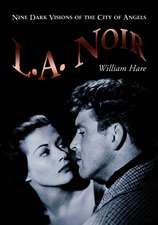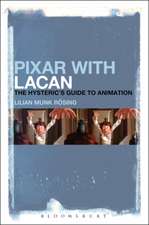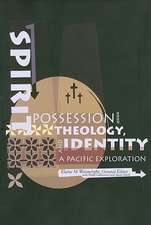Toy Story: How Pixar Reinvented the Animated Feature: Animation: Key Films/Filmmakers
Editat de Susan Smith, Noel Brown, Sam Summersen Limba Engleză Hardback – 24 ian 2018
| Toate formatele și edițiile | Preț | Express |
|---|---|---|
| Paperback (1) | 230.79 lei 6-8 săpt. | |
| Bloomsbury Publishing – 24 iul 2019 | 230.79 lei 6-8 săpt. | |
| Hardback (1) | 714.51 lei 6-8 săpt. | |
| Bloomsbury Publishing – 24 ian 2018 | 714.51 lei 6-8 săpt. |
Preț: 714.51 lei
Preț vechi: 1027.66 lei
-30% Nou
Puncte Express: 1072
Preț estimativ în valută:
136.72€ • 143.13$ • 113.13£
136.72€ • 143.13$ • 113.13£
Carte tipărită la comandă
Livrare economică 05-19 aprilie
Preluare comenzi: 021 569.72.76
Specificații
ISBN-13: 9781501324918
ISBN-10: 1501324918
Pagini: 256
Ilustrații: 30 bw illus
Dimensiuni: 152 x 229 mm
Greutate: 0.48 kg
Editura: Bloomsbury Publishing
Colecția Bloomsbury Academic
Seria Animation: Key Films/Filmmakers
Locul publicării:New York, United States
ISBN-10: 1501324918
Pagini: 256
Ilustrații: 30 bw illus
Dimensiuni: 152 x 229 mm
Greutate: 0.48 kg
Editura: Bloomsbury Publishing
Colecția Bloomsbury Academic
Seria Animation: Key Films/Filmmakers
Locul publicării:New York, United States
Caracteristici
Asserts the importance of Toy Story in relation to developments within the medium of animation, to contemporary culture and society, and to advancements within the industry
Notă biografică
Susan Smith is Reader in Film Studies at the University of Sunderland, UK. She is author of Elizabeth Taylor (BFI/Palgrave, 2012), Voices in Film (Wallflower Press, 2007), The Musical: Race, Gender and Performance (Columbia University Press, 2005) and Hitchcock: Suspense, Humour and Tone (BFI, 2000). She also co-edits the BFI's Film Stars series.Noel Brown is a Lecturer in Media and Communication at Liverpool Hope University, UK. He is author of The Hollywood Family Film (2012), British Children's Cinema (2016), The Children's Film (2017) and Contemporary Hollywood Animation (forthcoming), and is co-editor of Family Films in Global Cinema (2015).Sam Summers is a researcher at the Centre for Research in Media and Cultural Studies at the University of Sunderland, UK. His research focuses on the use of intertextual references in contemporary animation and DreamWorks' animation in general, with a view to contextualising and historicising the studio's role in the development of the medium.
Cuprins
Introduction (Noel Brown, Newcastle University, UK, Susan Smith, University of Sunderland, UK, and Sam Summers, University of Sunderland, UK)1. Toy Story, Pixar and Contemporary Hollywood (Peter Krämer, University of East Anglia, UK)2. Toy Story and the Hollywood Family Film (Noel Brown, Newcastle University, UK)3. The Cowboy, the Spaceman, and the Guru: Character and Convention in the Screenwriting of Toy Story (Andrew Gay, Southern Oregon University, USA)4. New and Inherited Aesthetics: Designing for the Toy Story Trilogy One Film at a Time (Heather Holian, University of North Carolina, USA)5. Rough and Smooth: The Everyday Textures of Toy Story (Lucy Fife Donaldson, University of St Andrews, UK)6. Toying with performance: Toy Story, Virtual Puppetry and Computer-Animated Film Acting(Christopher Holliday, King's College, London, UK)7. Toy Stories Through Song: Pixar, Randy Newman and the Sublimated Film Musical (Susan Smith, University of Sunderland, UK)8. Toys as a Site of Intertextuality (Sam Summers, University of Sunderland, UK)9. Fear, Guilt and the Future of Play in Toy Story (Karen Cross, University of Roehampton, UK)10. Mirrors and Shadows: Duality, Illusion and the Divided Self in Toy Story (Jane Batkin, University of Lincoln, UK)11. Woody, Buzz and the Koons Corollary. Or Why Toy Story is Art (Paul Wells, Longborough University, UK)12. Story is King: Understanding the Toy Story Franchise as an Allegory for the Studio Narrative of Pixar Animation (Helen Haswell, Queen's University Belfast, UK)13. An Interview with Steve Segal (Noel Brown, Newcastle University, UK)A Guide to Further ResearchContributorsBibliographyFilmography
Recenzii
Smith, Brown, and Summers' Toy Story examines Toy Story the film as a work of art, a cultural phenomenon, an industry game changer, and as beloved movie. In illuminating both how - and why - Toy Story is one of the most successful films of all time, this volume, like its namesake, is destined to become a classic.
Toy Story is a remarkable film for so many reasons, but the essays collected here place particular emphasis on its fascinating (and highly successful) blending of innovation and convention. By positioning it in relation to diverse continuities and changes in filmmaking, animation, storytelling, music, and art, ultimately the book serves as a kaleidoscopic exploration of the movie's enduring resonance and influence.
Toy Story the volume, like Toy Story the movie, offers many pleasures. Its discussions of Pixar's expressive textures, of the new animator as a kind of puppet master, of the cultural meanings of toys, and of the value, even subtlety possible in computer animation are both intellectually satisfying and welcome additions to animation scholarship. But many of these contributions also come with a clearly felt, almost emotional appreciation for what is demonstrably a great film and a testimony to what animation can accomplish. This book fully appreciates that film and, in turn, deserves to be appreciated.
Toy Story is a remarkable film for so many reasons, but the essays collected here place particular emphasis on its fascinating (and highly successful) blending of innovation and convention. By positioning it in relation to diverse continuities and changes in filmmaking, animation, storytelling, music, and art, ultimately the book serves as a kaleidoscopic exploration of the movie's enduring resonance and influence.
Toy Story the volume, like Toy Story the movie, offers many pleasures. Its discussions of Pixar's expressive textures, of the new animator as a kind of puppet master, of the cultural meanings of toys, and of the value, even subtlety possible in computer animation are both intellectually satisfying and welcome additions to animation scholarship. But many of these contributions also come with a clearly felt, almost emotional appreciation for what is demonstrably a great film and a testimony to what animation can accomplish. This book fully appreciates that film and, in turn, deserves to be appreciated.





























